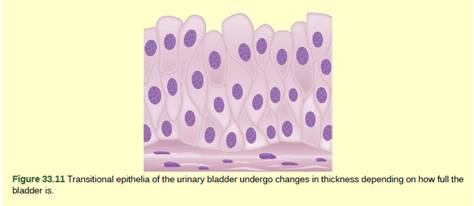
Concept explainers
Figure 33.11 Which of the following statements about types of epithelial cells is false?
- Simple columnar epithelial cells line the tissue of the lung.

Introduction:
Epithelial cells are present on the linings of various organs of the body. Their functions include protection, absorption, diffusion, transport, and secretion.
Answer to Problem 1VCQ
Correct answer:
The correct answer is option (a).
Explanation of Solution
Explanation for the correct answer:
Option (a) is given as simple columnar epithelial cells lining tissue of the lungs. However squamous epithelial tissue is present in the lining of the lungs to allow easy diffusion air. Hence, option (a) is correct.
Explanation for the incorrect options:
Option (b) is given as simple cuboidal epithelial cells are involved in the filtering of blood in the kidney. Cuboidal epithelial cells provide a larger surface area for absorption in the kidneys. Hence, option (b) is incorrect.
Option (c) is given as pseudostratified columnar epithelia occur in a single layer, but the arrangement of nuclei makes it appear that more than one layer is present. The statement is true as the cells have multiple nuclei, which are present in parallel lines and pseudostratified columnar epithelia appear like multicellular. Hence, option (c) is incorrect.
Option (d) is given as transitional epithelia change in thickness depending on how full the bladder is. The statement is correct as transitional epithalamia are flexible and present in bladder and ureter. Hence, option (c) is incorrect.
Squamous epithelia consist of a single layer of thin-walled cells that are present in the lining of the lungs to allow the diffusion of gases.
Want to see more full solutions like this?
Chapter 33 Solutions
Biology 2e
Additional Science Textbook Solutions
College Physics
Genetic Analysis: An Integrated Approach (2nd Edition)
Concepts of Genetics (12th Edition)
Campbell Biology in Focus
Campbell Essential Biology with Physiology (6th Edition)
Fundamentals of Anatomy & Physiology Plus Mastering A&P with eText - Access Card Package (10th Edition) (New A&P Titles by Ric Martini and Judi Nath)
- ________ tissues have closely linked cells and one free surface. a. Muscle b. Nerve c. Connective d. Epithelialarrow_forward__________, a specialized connective tissue, is mostly plasma with cellular components and various dissolved substances. a. Irregular connective tissue b. Blood c. Cartilage d. Bonearrow_forward___ tissues are sheetlike with one free surface. a. Epithelial b. Muscle c. Nervous d. Connectivearrow_forward
- Which of the following statements is NOT TRUE about tissues? A. The extracellular matrix of blood tissue is the plasma B. In adipose tissue, tiny cells are surrounded by very thick extra cellular matrix which is where all the fat is located C. Epithelial cells sometimes have cilia like the ones used in comb jellies and placozoans D. Nervous Tissue has only one cell type, the neuronarrow_forwardWhen looking at a slide of epithelial tissue under the microscope, you see several clearly defined layers of flat-shaped cells. Which of the following best describes the type of epithelial tissues viewed? simple squamous stratified squamous simple cuboidal stratified cuboidal psuedostratified columnararrow_forwardTwo types of tissues are classified as epithelium. what are they? skin and mucous membrane skin and cartilage mucous membrane and serous membrane cartilage and endotheliumarrow_forward
- Which of the followings is not a function of epithelial cells? (LO-A2) Secretion Excretion Absorption Protection Signalingarrow_forwardWhich type of epithelial cell is found in the urinary bladder? a. squamous b. cuboidal c. columnar d. transitionalarrow_forwardWhich of the following is a correct statement about a simple epithelium? a. All of the cells are in direct contact with the basement membrane. b. It protects against mechanical abrasion. c. It is formed from multiple layers of cells. d. It may contain the protein keratin.arrow_forward
- Which of the following types of epithelial tissues resemble rectangular pillars found in the lining of the digestive tract? Group of answer choices columnar epithelium cuboidal epithelium squamous epithelium pseudostratified epitheliumarrow_forwardAll of the following are characteristics of epithelial tissue EXCEPT: contains matrix avascularity covers or lines structures forms glands The aponeuroses seen in the anterior abdominal wall need to withstand forces of tension mainly in one direction. On the other hand, the tissue surrounding joints are likely to experience tension in multiple planes. What tissue would you expect to find in the joints? : Dense regular connective tissue Areolar connective tissue Dense irregular connective tissue Reticular connective tissuearrow_forwardA serous membrane is at this level of organization.arrow_forward
 Biology 2eBiologyISBN:9781947172517Author:Matthew Douglas, Jung Choi, Mary Ann ClarkPublisher:OpenStax
Biology 2eBiologyISBN:9781947172517Author:Matthew Douglas, Jung Choi, Mary Ann ClarkPublisher:OpenStax Human Biology (MindTap Course List)BiologyISBN:9781305112100Author:Cecie Starr, Beverly McMillanPublisher:Cengage Learning
Human Biology (MindTap Course List)BiologyISBN:9781305112100Author:Cecie Starr, Beverly McMillanPublisher:Cengage Learning Biology: The Unity and Diversity of Life (MindTap...BiologyISBN:9781305073951Author:Cecie Starr, Ralph Taggart, Christine Evers, Lisa StarrPublisher:Cengage Learning
Biology: The Unity and Diversity of Life (MindTap...BiologyISBN:9781305073951Author:Cecie Starr, Ralph Taggart, Christine Evers, Lisa StarrPublisher:Cengage Learning



